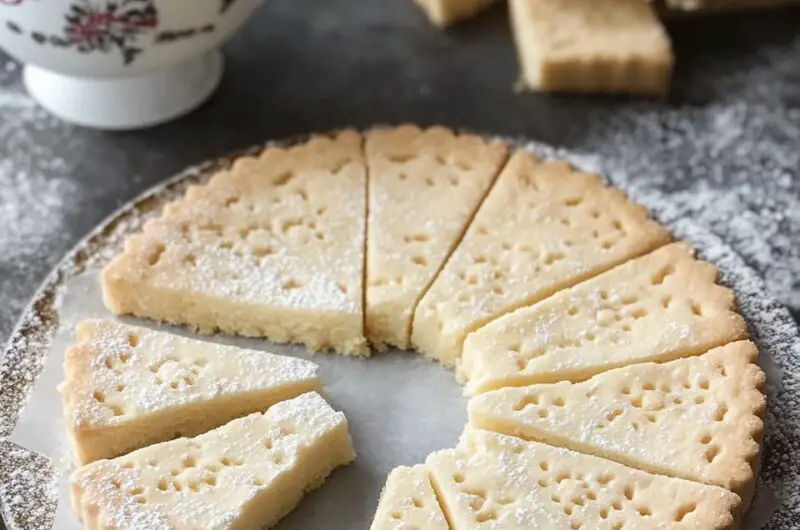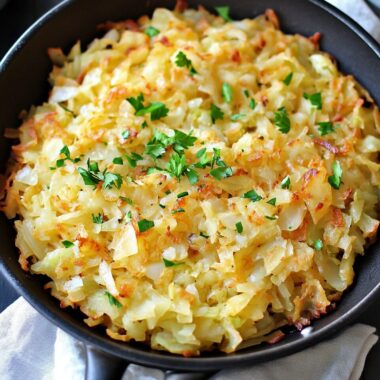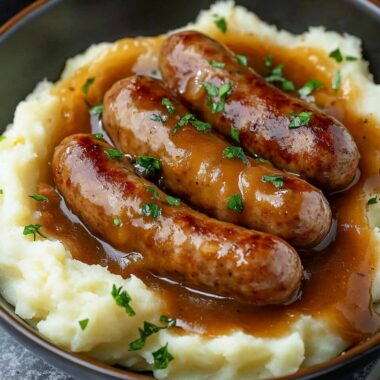The All-Butter Irish Shortbread is a timeless treasure that brings warmth and nostalgia to any kitchen. Known for its rich, buttery texture and light crumb, this treat captures the essence of traditional Irish baking. Whether it’s served with tea, coffee, or on a holiday cookie platter, each bite offers a delicate sweetness that melts in your mouth. Crafted with just a handful of pantry staples, this shortbread is perfect for both novice and seasoned bakers. The beauty lies in its simplicity no fancy techniques, no extravagant ingredients just good old-fashioned baking at its best. You can even customize them with citrus zest, chocolate drizzle, or a sprinkle of sea salt for a gourmet twist. From holiday gatherings to cozy weekends, this Irish shortbread is always a crowd-pleaser.
Full Recipe:
Ingredients:
-
1 cup (2 sticks) unsalted butter, softened
-
½ cup powdered sugar
-
1 teaspoon pure vanilla extract
-
2 cups all-purpose flour
-
¼ teaspoon salt
Directions:
-
Preheat oven to 325°F (165°C). Line a baking sheet with parchment paper.
-
In a large bowl, cream together softened butter and powdered sugar until light and fluffy.
-
Mix in the vanilla extract.
-
Gradually add the flour and salt, mixing until a soft dough forms.
-
Transfer dough to a lightly floured surface and gently knead until smooth.
-
Roll out dough to ½-inch thickness and cut into rectangles or desired shapes.
-
Place cookies on the prepared baking sheet, spacing slightly apart.
-
Use a fork to prick patterns into the tops of each cookie.
-
Bake for 18–22 minutes or until edges are lightly golden.
-
Let cool on the baking sheet for 5 minutes before transferring to a wire rack to cool completely.
Prep Time: 15 minutes | Cooking Time: 20 minutes | Total Time: 35 minutes
Kcal: 150 kcal | Servings: 24 cookies
The Timeless Appeal of All-Butter Irish Shortbread
Few baked goods can rival the elegance, simplicity, and charm of All-Butter Irish Shortbread. This beloved treat holds a special place in the culinary traditions of Ireland and beyond. With a history rooted in frugality and comfort, Irish shortbread has evolved into a global symbol of traditional baking. Made with just a handful of ingredients most notably, high-quality butter it showcases how something so simple can be so extraordinarily satisfying.
In this article, we will explore the cultural significance of Irish shortbread, the essential techniques behind achieving the perfect texture, tips for enhancing the basic recipe, and creative ways to serve it. Whether you’re a first-time baker or a seasoned pastry lover, Irish shortbread offers a delicious opportunity to slow down and savor life’s little indulgences.
A Brief History of Irish Shortbread
Irish shortbread’s lineage can be traced back to the broader family of shortbread found throughout the British Isles, with its most famous cousin being the Scottish shortbread. The term “short” refers to the high-fat content of the dough, which leads to the crumbly, melt-in-your-mouth texture characteristic of these cookies. What sets the Irish version apart is the generous use of pure, unsalted Irish butter, which adds a richness and depth of flavor that is unmistakable.
Historically, shortbread was a luxury item reserved for special occasions such as weddings, holidays, and festive gatherings. In rural Irish kitchens, families would save up their best butter for baking shortbread during Christmas or Easter. Passed down through generations, these recipes were often handwritten in cookbooks and tweaked by each baker to suit their family’s tastes.
What Makes Irish Shortbread Unique?
While shortbread variations exist in several countries, Irish shortbread distinguishes itself through the quality of the butter and the simplicity of its preparation. The traditional recipe calls for just a few ingredients: butter, flour, sugar, and a touch of salt. But don’t let its simplicity fool you each component plays a vital role in the final product.
The butter is the star of the show. Using European-style or Irish butter (such as Kerrygold) makes a noticeable difference. These butters typically have a higher fat content and a richer, creamier flavor than standard American butters, resulting in a more tender, flavorful shortbread.
Additionally, Irish shortbread recipes often avoid embellishments like chocolate chips, nuts, or fruit. Instead, they focus on perfecting the texture light, sandy, and delicately crumbly while letting the butter and sugar work their magic.
Tips for Perfect Irish Shortbread
Even though the ingredient list is short, achieving the ideal shortbread texture and flavor requires attention to detail and technique. Here are some key tips:
1. Use Cold, High-Quality Butter
The temperature and quality of your butter are crucial. Start with cold, cubed butter to ensure the dough doesn’t become greasy. Opt for a premium Irish butter for an authentic flavor.
2. Do Not Overmix
Overworking the dough can lead to tough shortbread. Mix until the dough just comes together—this helps preserve the light, crumbly texture.
3. Chill the Dough
Once the dough is formed, chilling it for at least 30 minutes will help it maintain shape during baking and enhance the final texture.
4. Bake Low and Slow
A lower oven temperature ensures even baking and prevents browning too quickly. The goal is a pale, golden hue, especially around the edges.
5. Cut Shapes Precisely
Irish shortbread is often cut into rectangles or rounds, and many bakers use a fork to prick the surface in a decorative pattern. This isn’t just for looks it also helps the cookies bake evenly.
Customizing Your Shortbread
Although purists might insist that shortbread should remain untouched, there is always room for creativity in the kitchen. Here are a few simple ways to add variety to your Irish shortbread:
-
Citrus Zest: Add a teaspoon of lemon or orange zest to the dough for a hint of brightness.
-
Herbs and Spices: A pinch of ground cardamom, cinnamon, or rosemary can give the cookies a subtle aromatic twist.
-
Chocolate Drizzle: Once baked and cooled, drizzle with melted dark or white chocolate for a decadent upgrade.
-
Dipped Edges: Dip one side of each cookie into melted chocolate and sprinkle with crushed pistachios or sea salt.
-
Infused Sugars: Replace plain sugar with vanilla sugar or lavender sugar for a floral note.
These customizations allow you to make the recipe your own while still honoring the tradition at its core.
Serving Suggestions and Pairings
Irish shortbread is incredibly versatile and fits a variety of serving contexts. It’s commonly enjoyed as an afternoon treat with a cup of black tea particularly Irish breakfast tea. The richness of the shortbread pairs beautifully with the boldness of a well-steeped tea.
For a more festive touch, serve your shortbread alongside:
-
Irish Coffee – The buttery sweetness complements the strong, whiskey-laced drink.
-
Cheese and Fruit Boards – Use shortbread as a sweet contrast to sharp cheeses and fresh fruits.
-
Ice Cream – Crumble shortbread over vanilla bean or coffee ice cream for added crunch.
-
Holiday Cookie Platters – Include Irish shortbread as the classic, buttery anchor among more vibrant cookies.
It also makes an excellent edible gift. Pack a dozen into a rustic tin or a cellophane bag tied with ribbon for holidays, birthdays, or hostess gifts.
Irish Shortbread and Seasonal Celebrations
This cookie is especially popular during St. Patrick’s Day celebrations, but it shines just as brightly at Christmas, Easter, and even weddings. In many households, baking a batch of shortbread is a family tradition passed down from grandparents to children. It symbolizes comfort, generosity, and the joy of shared meals.
Thanks to its long shelf life, shortbread can also be made ahead of time. Stored in an airtight container, it remains fresh for over a week and even freezes well making it a perfect make-ahead option for busy holiday seasons.
Why You Should Bake Irish Shortbread
What makes this recipe a must-try is not just its irresistible flavor but its nostalgic and cultural resonance. Irish shortbread is a culinary hug a simple yet luxurious indulgence that connects us to old-world traditions and the joy of home baking.
Whether you’re preparing it for the first time or have fond memories of it from childhood, baking Irish shortbread is a gratifying experience. The process is meditative, the ingredients are humble, and the result is deeply satisfying.
Conclusion:
In a world full of elaborate desserts and complex flavors, Irish shortbread stands out as a testament to simplicity and tradition. Its minimal ingredients highlight the importance of quality over quantity, and its unpretentious charm wins over hearts with every bite.
Perfectly crumbly, subtly sweet, and rich with butter, Irish shortbread is a celebration of home, heritage, and the simple pleasures of life. Whether enjoyed during a quiet moment with tea or shared with loved ones on special occasions, this classic cookie remains timeless.








